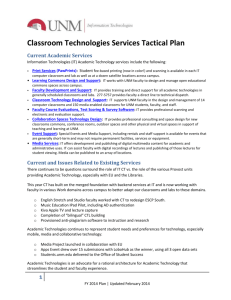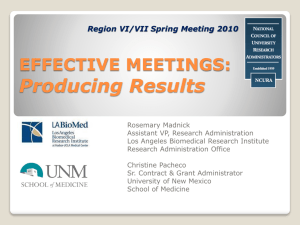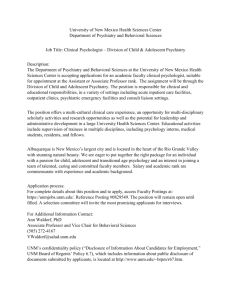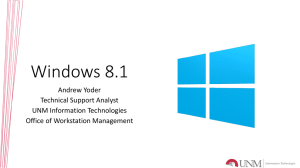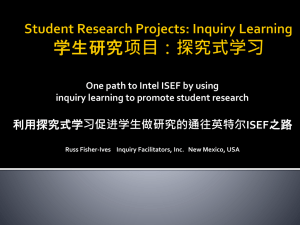UNM – West Campus in the New Rio Rancho City Center
advertisement
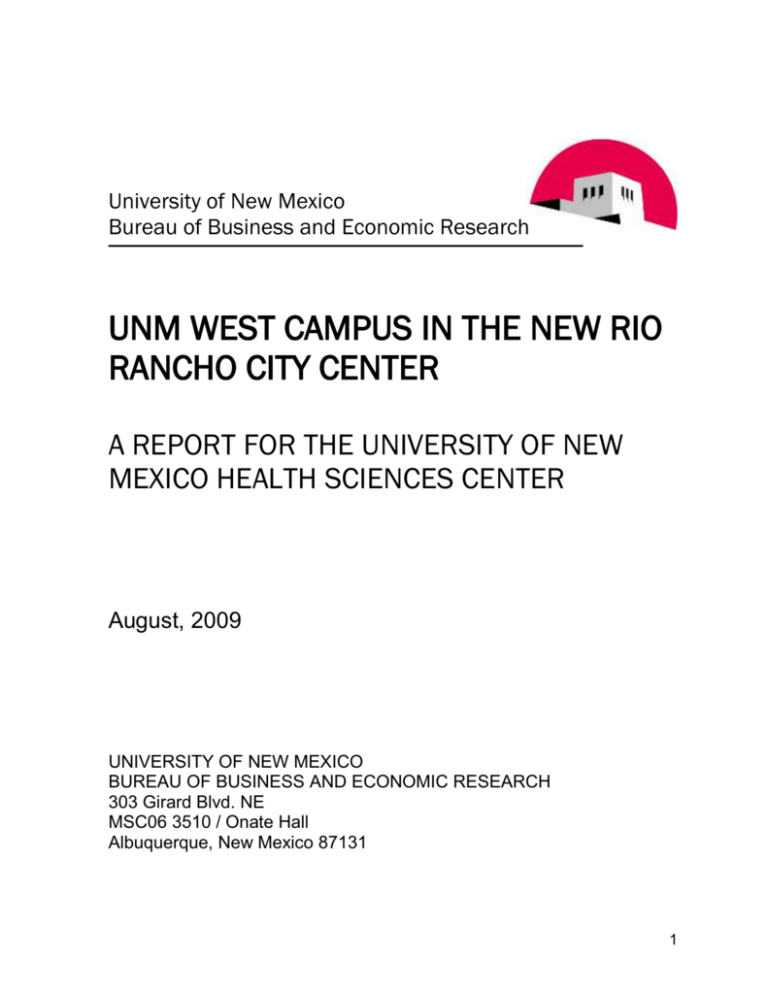
University of New Mexico Bureau of Business and Economic Research UNM WEST CAMPUS IN THE NEW RIO RANCHO CITY CENTER A REPORT FOR THE UNIVERSITY OF NEW MEXICO HEALTH SCIENCES CENTER August, 2009 UNIVERSITY OF NEW MEXICO BUREAU OF BUSINESS AND ECONOMIC RESEARCH 303 Girard Blvd. NE MSC06 3510 / Onate Hall Albuquerque, New Mexico 87131 1 2 University of New Mexico Bureau of Business and Economic Research UNM WEST CAMPUS IN THE NEW RIO RANCHO CITY CENTER A REPORT FOR THE UNIVERSITY OF NEW MEXICO HEALTH SCIENCES CENTER August, 2009 Dr. Lee A. Reynis, Director Andrew Webb Molly Bleecker, MA UNIVERSITY OF NEW MEXICO BUREAU OF BUSINESS AND ECONOMIC RESEARCH 303 Girard Blvd. NE MSC06 3510 / Onate Hall Albuquerque, New Mexico 87131 3 4 Table of Contents UNM WEST CAMPUS IN THE NEW RIO RANCHO CITY CENTER ......................... 1 Introduction ................................................................................................................. 1 The UNM West Campus ............................................................................................. 2 Potential Catchment Area........................................................................................ 4 Demographics for Rio Rancho and Counties in the Catchment Area .................. 8 Demographic Profile of Communities in the Catchment Area as Defined by Zip Code Tabulation Areas ...................................................................................... 15 Businesses Currently Serving the UNM West Campus Area .................................... 18 Business and Community Leader Hopes and Visions for the UNM West Campus ... 21 Table of Tables Table 1. Selected Demographic Data on the City of Rio Rancho and the Counties of Sandoval, Bernalillo and Santa Fe ............................................................... 10 Table 2. Estimated Population and Population Growth between 2000 and 2007: Cities of Rio Rancho, Albuquerque and Santa Fe and the Counties of Sandoval, Bernalillo and Santa Fe ............................................................... 12 Table 3. BBER Population Projections for Sandoval County ................................... 14 Table 4. BBER Population Projections for Area that Includes Sandoval, Bernalillo and Santa Fe Counties ................................................................................ 14 Table 5. 2000 Population, Age Distribution, and Percent Minority, Selected Zip Codes for UNM West Catchment Area ........................................................ 16 Table 6. Demographic Indicators for Selected Zip Code Areas, Census 2000 ........ 17 Table 7. Types of Businesses within 20 Minutes of the UNM West Campus ........... 19 Table of Figures Figure 1. Land Ownership/Uses near the New Rio Rancho City Center .................... 2 Map 1. Current Zip Code Addresses of UNM Students Studying in Rio Rancho ....... 3 Map 2. The Network of Roads Connecting UNM West to the Larger Region ............ 5 Map 3. Drive Times to UNM West Campus ............................................................... 6 Map 4. Drive Times to UNM Main Campus in Albuquerque ....................................... 7 Map 5. Service Businesses within 20 Minutes of UNM West ................................... 20 5 UNM WEST CAMPUS IN THE NEW RIO RANCHO CITY CENTER Introduction The University of New Mexico is in the process of creating a campus in Rio Rancho. While the first phase of construction has begun, the curriculum to be offered at the new campus has yet to be finalized. This report serves to augment the existing research on the demand for programs at the new Rio Rancho campus, and was undertaken at the request of the University’s Health Sciences Center and an ad hoc committee of UNM administrators. Elizabeth Miller and Dr. Santa Falcone, Special Assistants to the Vice President for UNM West and and Branch Initiatives, both provided helpful guidance for this project. Included in this report is BBER’s estimate of the new campus’s catchment area, based upon drive-time analyses; demographic information for the population within the catchment area; an inventory and map of existing businesses that could serve the campus students and staff; and information on the Rio Rancho-area business and community leaders’ hopes and visions for the new campus. 1 The UNM West Campus The development of a UNM West Campus to include a UNM teaching hospital opens up all kinds of possibilities for meeting the education and training needs of the residents and businesses of Central New Mexico and for repositioning UNM better to meet these needs. As Figure 1 indicates, the UNM West campus will be adjacent to the new Rio Rancho City Center. Land uses/ownership in the vicinity of UNM West campus are sketched out in this schematic from a draft of the UNM West Comprehensive Campus Plan. Figure 1. Land Ownership/Uses near the New Rio Rancho City Center Source: UNM West Comprehensive Campus Plan 2 As Map 1 indicates, currently most of the students at UNM’s Rio Rancho branch are from Rio Rancho and other Westside zip codes. Map 1. Current Zip Code Addresses of UNM Students Studying in Rio Rancho Based on 2008 Survey of Rio Rancho students provided by Dr. Santa Falcone 3 Potential Catchment Area The potential area from which the campus will draw students depends critically on the programs and curriculum offered at UNM West and how these relate to offerings on the main campus. For example, if UNM West were to promote itself as offering a 4year liberal arts college experience, with a dormitory housing option, it might draw broadly from central New Mexico, as a public version of this option is currently not available. If UNM West instead becomes a smaller version UNM Main Campus, with some similar programs and courses, the catchment area may be very small, unless it is somehow able to structure offerings to appeal to students in a wider area. For example, the 8-week course option seems to be particularly attractive to some students. If UNM West provides some specialized programs unavailable on the main campus it may draw from a larger area, at least for these programs, but the catchment area is likely to depend on commute times. Regardless of the ultimate configuration of programs, the main limiting factor for potential students is how far they must travel to attend classes there. Map 2, also from the comprehensive campus plan, puts the UNM campus within the network of major roads that serve the larger metropolitan area. This map was used by BBER in determining drive times to the campus from the locations within the larger region. Drive-times to the UNM West campus are presented by 20 minute intervals in Map 3. Map 4 presents a similar analysis for the UNM Main Campus in Albuquerque. Its location near the intersection of I-25 and I-40 makes road access to the main campus relatively easy. The major transportation barriers for many are the difficulties and the expense associated with parking near campus. These barriers will exist to a much lesser degree at the UNM West campus. Currently travel to the UNM West campus is hampered by the local road network and speed limits, which should improve in the future. Map 3 suggests the potential future catchment area for the UNM West campus, assuming UNM eschews the 4-year liberal arts option in favor of offering 4-year degree programs and a limited number of specialized graduate and undergraduate programs some of which may not be offered elsewhere. In this case, the catchment area is likely to depend on the frequency and timing of the classes and on how long it takes to commute to the campus. As is true currently, a Rio Rancho campus should draw from Rio Rancho, Corrales, Bernalillo, and some of zip code 87114 as well as from Santa Ana Pueblo. All these locations are within 20 minutes of the proposed campus. The rest of zip code 87114, the Westside zip code 87120 and the North Valley (zip code 87107) south of Alameda and some areas south of I-40 are within 40 minutes, as is much of the older part of Albuquerque, the communities of Placitas, Algodones and San Ysidro and the pueblos of Sandia, Zia, and San Felipe. While we have not kept all the older areas of Albuquerque and those areas south of I-40 in the analysis, we have included the North Valley zip code 87107 in view of the current enrollment from that zip code and the access provided by Alameda Bridge and perhaps that provided at Montano or Paseo del Norte. 4 Map 2. The Network of Roads Connecting UNM West to the Larger Region Source: UNM West Comprehensive Campus Plan 5 Map 3. Drive Times to UNM West Campus Source: ESRI® Business Analyst™; UNM-BBER 6 Map 4. Drive Times to UNM Main Campus in Albuquerque Source: ESRI® Business Analyst™; UNM-BBER 7 Within a drive time of one hour are the additional communities of Pena Blanca, Cochiti and La Cienega, as well as Cochiti and Santo Domingo pueblos. Also, within one hour are communities on the near east side of the Sandia Mountains, including Tijeras, although the UNM Main Campus is within 40 minutes of these communities and on route to UNM West. A similar argument would seem to rule out areas to the south in Valencia County, like Los Lunas. Of course, a few students from both these areas might avail themselves of specialized offerings not otherwise available in Central New Mexico. Extending the drive time to 80 minutes nets major population centers like those of the larger Santa Fe area, as well as communities to the northwest, like Ponderosa, Jemez Springs and Jemez Pueblo. The extension of RailRunner service to Santa Fe provides access via the station on State Road 550 on the north side of Bernalillo. Train service may not shorten the commute, but it will make UNM West more attractive, particularly if shuttle service is opened up to UNM West campus similar to the service currently provided both to UNM Main Campus and to UNM Hospital. BBER questions whether students in communities further to the north of Santa Fe, like Pojoaque, Espanola and White Rock, will be willing to travel an hour and forty minutes or more, and particularly given that there are higher education options available in Los Alamos (also UNM), Espanola, El Rito and Taos (UNM). Students in Cuba, who would have a similar commute, have fewer options, so we have left them in the analysis. Demographics for Rio Rancho and Counties in the Catchment Area Assuming the most conservative of drive times, BBER defines the catchment area as covering all of Rio Rancho and parts of three counties: Sandoval, Bernalillo and Santa Fe. Table 1 presents data from Census 2000 and for the 2005-07 period from the American Community Survey (ACS) on Rio Rancho and the three counties.1 The first set of figures relate to the total population, the number of men and women and the age breakdown. As might be expected, the median age in Santa Fe County is close to 40, while in Bernalillo and Sandoval Counties the median age is closer to 35. These figures are followed by those dealing with ethnicity and race. Non-Hispanic whites make up the majority in Rio Rancho and in Sandoval County, while both Bernalillo and Santa Fe counties are majority minority counties, with very large Hispanic populations. With respect to household type, some 75% of households in Rio Rancho and Sandoval County are families, versus closer to 60% in Bernalillo and Santa Fe Counties. These latter two counties have much higher percentages of people living by themselves. The data in the table on the top of the following page deal with school enrollment. Note the much higher percentages of those in college or graduate school in Bernalillo County, presumably reflecting the presence there of the UNM Main campus as well as the main campus for Central New Mexico Community College (CNM). 1 The data are available electronically in Excel from BBER, with comparable information on New Mexico and the US. 8 Educational attainment shows some variation across the area. The percentage of those with at least a high school diploma or equivalent is very high at over 90 percent in Rio Rancho, yet the percentage of those with a bachelors or more is lower than in either Bernalillo County or Santa Fe County. The estimates of population from the ACS are approximate. Table 2 below provides BBER’s estimates of population for the cities of Rio Rancho, Albuquerque and Santa Fe and the counties of Sandoval, Bernalillo and Santa Fe in 2007 versus the 2000 Census count for each of these areas. The population for Rio Rancho was just under 80,000 in 2007, while the three counties had a combined population in excess of 900,000. Over the decade, Rio Rancho has grown at an annualized rate of 7.7%, while annual population growth in the whole three county area was only 2.3%. 9 Table 1. Selected Demographic Data on the City of Rio Rancho and the Counties of Sandoval, Bernalillo and Santa Fe Rio Rancho City 2000 2005-07 Subject Total population SEX AND AGE Male Female Under 5 years 5 to 9 years 10 to 14 years 15 to 19 years 20 to 24 years 25 to 34 years 35 to 44 years 45 to 54 years 55 to 59 years 60 to 64 years 65 to 74 years 75 to 84 years 85 years and over Median age (years) RACE AND ETHNICITY Hispanic or Latino (of any race) White Non-Hispanic Total Minority Number % Number Sandoval County 2000 2005-07 Number % % Number 100 69,080 100 89,908 100 111,855 100 556,678 100 618,845 100 129,292 100 141,207 100 25,106 26,659 48.5 51.5 33,536 35,544 48.5 51.5 43,848 46,060 48.8 51.2 54,781 57,074 49.0 51.0 271,904 284,774 48.8 51.2 303,539 315,306 49.0 51.0 63,246 66,046 48.9 51.1 69,487 71,720 49.2 50.8 3,861 4,265 4,457 3,791 2,369 7,075 9,500 6,765 2,074 1,550 2,937 2,357 764 7.5 8.2 8.6 7.3 4.6 13.7 18.4 13.1 4 3 5.7 4.6 1.5 4,993 4,779 5,782 4,763 4,731 9,830 11,039 9,755 3,593 2,605 3,272 2,587 1,351 7.2 6.9 8.4 6.9 6.8 14.2 16.0 14.1 5.2 3.8 4.7 3.7 2.0 6,589 7,638 7,885 6,776 4,463 11,400 15,662 12,667 4,164 3,122 5,085 3,424 1,033 7.3 8.5 8.8 7.5 5 12.7 17.4 14.1 4.6 3.5 5.7 3.8 1.1 7,421 7,266 9,151 8,163 7,876 15,028 15,945 17,143 6,726 5,037 6,181 3,926 1,992 6.6 6.5 8.2 7.3 7.0 13.4 14.3 15.3 6.0 4.5 5.5 3.5 1.8 38,566 39,016 39,426 40,728 40,828 79,423 89,615 78,174 26,311 20,435 33,904 22,808 7,444 6.9 7 7.1 7.3 7.3 14.3 16.1 14 4.7 3.7 6.1 4.1 1.3 46,292 41,100 41,294 42,140 45,525 88,581 86,514 88,277 38,380 27,408 37,630 26,172 9,532 7.5 6.6 6.7 6.8 7.4 14.3 14.0 14.3 6.2 4.4 6.1 4.2 1.5 7,986 8,523 9,129 8,623 7,364 17,001 21,444 22,355 7,458 5,506 7,901 4,466 1,536 6.2 6.6 7.1 6.7 5.7 13.1 16.6 17.3 5.8 4.3 6.1 3.5 1.2 8,005 7,974 8,780 9,038 8,920 18,078 20,245 22,711 11,835 7,813 9,880 5,394 2,534 5.7 5.6 6.2 6.4 6.3 12.8 14.3 16.1 8.4 5.5 7.0 3.8 1.8 34.6 35.1 35.7 Number % 35.0 Number Santa Fe County 2000 2005-07 51,765 35.1 % Bernalillo County 2000 2005-07 % 35.5 Number % 37.9 Number % 40.0 14,329 33,176 18,589 27.7 64.1 35.9 22,648 40,481 28,599 32.8 58.6 41.4 14,329 45,227 44,681 27.7 50.3 49.7 35,938 55,251 56,604 32.1 49.4 50.6 233,565 268,972 287,706 42.0 48.3 51.7 277,189 274,656 344,189 44.8 44.4 55.6 63,405 58,790 70,502 49 45.5 54.5 70,659 62,596 78,611 50.0 44.3 55.7 Black or African American American Indian and Alaska Native Asian Some other race Two or more races 1,376 1,226 758 5,626 2,135 2.7 2.4 1.5 10.9 4.1 2,249 1,285 1,152 8,075 2,818 3.3 1.9 1.7 11.7 4.1 1,535 14,634 894 5,626 3,117 1.7 16.3 1.0 10.9 3.5 2,468 15,506 1,392 12,192 3,422 2.3 14.3 1.3 11.3 3.1 15,401 23,175 10,751 90,020 23,480 2.8 4.2 1.9 16.2 4.2 19,350 28,799 13,875 110,264 21,015 3.1 4.7 2.2 17.8 3.4 826 3,982 1,133 23,030 5,268 0.6 3.1 0.9 17.8 4.1 1,286 4,485 1,453 24,474 3,584 0.9 3.3 1.1 17.8 2.5 HOUSEHOLDS BY TYPE Total households Family households (families) With own children under 18 years Married-couple family With own children under 18 years Female householder, no husband With own children under 18 years Nonfamily households Householder living alone Householder 65 years and over 18,995 14,112 7,651 11,283 5,871 1,962 1,238 4,883 3,944 1,499 100 74.3 40.3 59.4 30.9 10.3 6.5 25.7 20.8 7.9 24,767 17,444 8,854 13,557 6,216 2,667 1,892 7,323 5,721 1,830 100.0 70.4 35.7 54.7 25.1 10.8 7.6 29.6 23.1 7.4 31,411 23,632 12,131 18,136 8,898 3,817 2,252 7,779 6,260 2,165 100 75.2 38.6 57.7 28.3 12.2 7.2 24.8 19.9 6.9 38,606 27,437 12,972 20,814 9,058 4,608 2,747 11,169 8,783 2,936 100.0 71.1 33.6 53.9 23.5 11.9 7.1 28.9 22.8 7.6 220,936 141,237 69,419 101,523 45,545 28,393 17,406 79,699 62,961 17,482 100 63.9 31.4 46 20.6 12.9 7.9 36.1 28.5 7.9 251,101 152,873 73,292 107,903 45,763 31,551 20,399 98,228 80,505 21,509 100.0 60.9 29.2 43.0 18.2 12.6 8.1 39.1 32.1 8.6 52,482 32,787 15,954 23,900 10,443 6,159 3,864 19,695 15,413 3,894 100.0 62.5 30.4 45.5 19.9 11.7 7.4 37.5 29.4 7.4 52,956 32,102 14,134 23,829 8,967 5,952 3,633 20,854 16,315 4,992 100.0 60.6 26.7 45.0 16.9 11.2 6.9 39.4 30.8 9.4 10 Table 1. Selected Demographic Data on the City of Rio Rancho and the Counties of Sandoval, Bernalillo and Santa Fe, Continued Rio Rancho City 2000 2005-07 Subject SCHOOL ENROLLMENT Population 3 years & over enrolled in school Nursery school, preschool Kindergarten Elementary school (grades 1-8) High school (grades 9-12) College or graduate school Number % Number Sandoval County 2000 2005-07 % Number % Number Bernalillo County 2000 2005-07 Santa Fe County 2000 2005-07 % Number % Number % Number % Number % 15,140 801 788 7,158 3,343 3,050 100 5.3 5.2 47.3 22.1 20.1 19,680 1,297 1,346 7,760 4,561 4,716 100 6.6 6.8 39.4 23.2 24.0 26,442 1,667 1,465 12,948 5,947 4,415 100 6.3 5.5 49 22.5 16.7 30,908 1,952 1,936 12,601 7,303 7,116 100 6.3 6.3 40.8 23.6 23.0 156,057 8,781 7,516 63,412 31,983 44,365 100 5.6 4.8 40.6 20.5 28.4 172,632 10,150 7,682 64,939 32,973 56,888 100 5.9 4.4 37.6 19.1 33.0 33,486 1,654 1,687 14,699 7,152 8,294 100 4.9 5 43.9 21.4 24.8 34,400 2,010 1,841 13,466 7,876 9,207 100 5.8 5.4 39.1 22.9 26.8 32,935 619 2,272 100 1.9 6.9 44,032 912 2,572 100 2.1 5.8 56,479 2,575 5,326 100 4.6 9.4 71,978 2,844 5,765 100 4.0 8.0 358,680 21,674 34,184 100 6 9.5 402,494 25,051 32,738 100 6.2 8.1 87,870 5,799 7,831 100 6.6 8.9 98,490 6,723 7,660 100 6.8 7.8 9,359 9,552 2,978 5,539 2,616 28.4 29 9 16.8 7.9 12,871 11,581 3,863 8,099 4,134 29.2 26.3 8.8 18.4 9.4 16,157 14,104 4,288 8,796 5,233 28.6 25 7.6 15.6 9.3 21,228 16,941 5,521 12,325 7,354 29.5 23.5 7.7 17.1 10.2 88,853 84,120 20,413 62,466 46,970 24.8 23.5 5.7 17.4 13.1 100,024 89,727 28,095 70,169 56,690 24.9 22.3 7.0 17.4 14.1 17,308 19,421 5,068 17,840 14,603 19.7 22.1 5.8 20.3 16.6 23,315 17,335 4,746 19,864 18,847 23.7 17.6 4.8 20.2 19.1 EDUCATIONAL ATTAINMENT Population 25 years and over Less than 9th grade 9th to 12th grade, no diploma High school graduate (includes equivalency) Some college, no degree Associate degree Bachelor's degree Graduate or professional degree Percent high school graduate or higher Percent bachelor's degree or higher 91.2 24.8 92.1 27.8 86.0 24.8 88.0 27.3 84.4 30.5 85.6 31.5 84.5 36.9 85.4 39.3 Median household income (dollars) Mean household income (dollars) 47,169 54,498 63,489 44,949 53,848 65,033 38,788 45,022 60,727 42,207 51,341 74,635 Median family income (dollars) Mean family income (dollars) Percent of families below poverty level 52,233 62,906 71,144 48,984 62,022 72,120 46,613 57,221 71,780 50,000 61,796 85,541 INCOME IN PREVIOUS YEAR * 3.7 5.7 9.0 8.1 10.2 11.1 9.4 8.7 * Income estimates from the ACS are not strictly comparable with those from the 2000 Census. Parallel data collection in 2000 revealed that ACS data understated income reported in the Census. Sources: Census 2000, PFS 1 and PFS 2; American Community Survey, 2005-07 Period Estimates 11 Table 2. Estimated Population and Population Growth between 2000 and 2007: Cities of Rio Rancho, Albuquerque and Santa Fe and the Counties of Sandoval, Bernalillo and Santa Fe Growth Over Seven Years Using the BBER 2007 Population Estimates Geography Bernalillo County City of Albuquerque Sandoval County City of Rio Rancho* Santa Fe County City of Santa Fe Three County Totals Census Bureau April 1, 2000 BBER Population July 1, 2007 Estimates Base Estimate 556,002 644,023 449,380 526,694 90,584 123,694 51,772 79,746 129,287 146,295 63,358 70,138 775,873 914,012 2000 Share of County 80.82% 57.15% 49.01% 2007 Population Share of Change County 2000-2007 88,021 81.78% 77,314 33,110 64.47% 27,974 17,008 47.94% 6,780 138,139 7-Year % Increase 15.83% 17.20% 36.55% 54.03% 13.16% 10.70% 17.80% 2000-2007 Annualized Growth Rate 2.26% 2.46% 5.22% 7.72% 1.88% 1.53% 2.34% * The Rio Rancho estimate includes both the Bernalillo County and Sandoval County portions of the city. Therefore, a small portion of Bernalillo County's population is included underneath the Sandoval County listing. Note: Bernalillo and Sandoval County estimates produced in partnership with the Mid-Region Council of Governments. Review of working numbers and input data were generously shared by the City of Santa Fe, the City of Roswell, the City of Farmington, and the City of Las Cruces. Source: BBER Population Estimates Program and U.S. Census Bureau, Population Division, 2007 round of estimates. 12 Table 3 provides BBER’s population projections by age group for Sandoval County, while Table 4 provides the projections for the three counties combined. Note the faster growth projected for Sandoval County (and Rio Rancho, which has been growing faster than the rest of the county). In both tables, we have highlighted the 15 to 19 and 20-24 age groups, which include people in their late teens and early 20s – the more traditional college student. Note that the 15-19 year old group shrinks after 2015, and that this causes a similar shrinkage in the 20-24 year old group five years later. A similar but far more pronounced shrinkage is evident in the statewide numbers and reflects the combined effects of an aging population with those of declining fertility. 13 Table 3. BBER Population Projections for Sandoval County Distribution of Projected Population for Both Sexes from July 1, 2005 to July 1, 2035 Both Sexes Age groups 0-4 5-9 10 - 14 15 - 19 20 - 24 25 - 29 30 - 34 35 - 39 40 - 44 45 - 49 50 - 54 55 - 59 60 - 64 65 - 69 70 - 74 75 - 79 80 - 84 85 + All Ages % Annual Growth All Ages 15-24 Age Group 2005 5,266 8,458 9,320 8,145 5,054 5,208 6,481 9,256 10,215 9,438 7,874 5,715 4,083 3,610 3,583 3,398 1,745 256 107,104 2010 6,926 5,759 9,460 10,609 9,395 5,996 5,928 7,301 10,338 11,528 10,715 8,919 6,466 5,078 3,595 3,418 3,002 1,241 125,675 2015 8,584 7,404 6,733 10,711 11,808 10,282 6,690 6,727 8,368 11,610 12,736 11,662 9,527 8,304 5,024 3,500 3,070 1,347 144,087 2020 10,590 9,058 8,377 7,990 11,913 12,687 10,955 7,486 7,799 9,668 12,824 13,652 12,191 11,744 7,633 4,520 2,971 1,257 163,315 2025 11,690 11,067 10,030 9,632 9,204 12,792 13,354 11,730 8,559 9,108 10,918 13,750 14,140 14,070 10,640 6,737 3,779 1,393 182,592 2030 11,811 12,165 12,038 11,283 10,841 10,100 13,464 14,119 12,780 9,869 10,374 11,902 14,255 15,448 13,001 9,537 5,724 2,111 200,822 2035 12,030 12,286 13,135 13,292 12,489 11,731 10,785 14,234 15,157 14,063 11,135 11,380 12,493 15,461 14,683 11,977 8,288 3,188 217,806 3.20 8.32 2.73 2.37 2.51 -2.47 2.23 -1.10 1.90 3.22 1.62 3.06 Source: Bureau of Business and Economic Research, University of New Mexico Table 4. BBER Population Projections for Area that Includes Sandoval, Bernalillo and Santa Fe Counties Distribution of Projected Population for Both Sexes from July 1, 2005 to July 1, 2035 Both Sexes Age groups 0-4 5-9 10 - 14 15 - 19 20 - 24 25 - 29 30 - 34 35 - 39 40 - 44 45 - 49 50 - 54 55 - 59 60 - 64 65 - 69 70 - 74 75 - 79 80 - 84 85 + All Ages Annual Growth All Ages 15-24 Age Groups 2005 41,389 58,255 62,861 63,513 56,281 51,149 55,627 70,297 74,896 76,249 69,614 49,019 36,713 29,126 28,098 25,596 13,689 2,545 2010 66,144 45,996 63,709 68,139 68,267 61,594 56,505 61,553 78,572 82,255 82,857 75,784 54,765 35,537 29,389 27,048 22,756 9,335 2015 73,356 70,977 51,634 69,209 73,064 73,763 67,124 62,658 70,607 86,580 88,426 88,190 79,843 51,963 38,633 31,163 26,520 11,296 2020 79,017 78,067 76,545 57,044 74,067 78,470 79,169 73,174 72,402 80,157 93,661 94,705 93,022 74,526 51,907 37,862 28,726 11,905 2025 81,834 83,603 83,500 81,815 62,021 79,430 83,823 85,124 83,618 83,123 87,840 100,299 99,860 82,386 71,891 49,183 34,030 13,591 2030 85,474 86,518 89,140 88,866 86,726 67,490 84,837 89,813 96,408 95,600 91,467 95,305 106,000 83,413 79,731 67,507 44,030 16,917 2035 91,597 90,237 92,141 94,596 93,845 92,208 73,038 90,946 102,483 110,615 105,710 100,900 103,354 82,499 80,187 74,229 59,308 23,112 864,918 990,204 1,115,004 1,234,427 1,346,972 1,455,244 1,561,008 2.71 2.60 2.37 0.84 2.03 -1.63 1.75 1.85 1.55 3.99 1.40 1.41 Source: Bureau of Business and Economic Research, University of New Mexico 14 Demographic Profile of Communities in the Catchment Area as Defined by Zip Code Tabulation Areas In 2000, the zip codes identified above as comprising the catchment area for UNM West accounted for 332 thousand people, or about 40% of the total number living within the three county area. Table 5 provides the detail on the age and sex composition of the population in each of the zip codes or Zip Code Tabulation Areas (ZCTAs) identified by Dr. Santa Falcon, Special Assistant to the Vice President for UNM West, as being of interest and falling within the catchment area discussed above. The top portion of the table focuses on the age-sex composition of the population in each of the zip codes in 2000. In some communities the percentage of the population under 18 is very large, such as in Santo Domingo Pueblo (48%), while in others, like Cochiti Lake, the percentage of young people is quite small (9%). The bottom portion of the table indicates the percent of the population in each age/sex category who were minority, i.e., Hispanic or not white alone. The communities in the area, which includes the seven Bernalillo and Sandoval county pueblos as well as those proximate to Santa Fe in Santa Fe County, are incredibly diverse in terms of their racial and ethnic composition. Overall, forty-seven percent self identify as white non Hispanic/Latino, so minorities are in the majority as they are in the state as a whole. About 30% of the population self-identify as Hispanic or Latino; about 7% as Native American only. Non-Hispanic whites make up 79% of the population in Jemez Springs, while in many of the pueblo communities and in Cuba, the minority population is over 90%. Table 6 examines selected socio-economic indicators for the same geography. The first two indicators look at educational attainment, specifically, the percent of the population 25 and older without a high school diploma and the percent with a bachelors degree or higher. Again, note the tremendous variability depending upon which zip code is chosen. Also, note the differences between men and women. The third indicator is a more current look at the drop-out rate among teens 16-19. Across the zip codes, this drop out rate is 13.3%. However, the figures for particular zip codes vary from 0 to over 60% in Pena Blanca. The next set of indicators deal with income. Median household incomes in 1999 range from roughly $16,500 in Cuba to over $60,000 in Corrales and Jemez Springs. The percentage of the population below poverty ranges from 5.3% in Rio Rancho to over 50% in Cuba. 15 Table 5. 2000 Population, Age Distribution, and Percent Minority, Selected Zip Codes for UNM West Catchment Area 5-Digit ZCTA Total Population Male: Under 18 years 18 - 21 22 to 24 years 25 to 44 years 45 - 64 65 - 74 75 and older 85 years and over Female: Under 18 years 18 - 21 22 to 24 years 25 to 44 years 45 - 64 65 - 74 75 and older 85 years and over All Selected ZCTAs Bernalillo, Algodones Sandia P, Budaghers Santa San Felipe Anna P, Pueblo Tamaya 87001 87004 Cerrillos Cuba Jemez Pueblo 87010 87013 87024 Jemez Springs Pena Blanca Placidas Ponderosa Corrales 87025 87041 87043 87044 87048 Santo San Domingo Ysidro, Zia Pueblo Pueblo 87052 87053 Cochiti Pueblo Cochiti Lake North Valley West Side, Alameda West Side, Taylor Ranch Rio Rancho Santa Fe, Agua Fria, Nambe, San Ildefonso Pueblo, Pojoaque 87072 87083 87114 87120 87107 87124 87501 Santa Fe City, La Cienega Glorieta Lamy, Paguate 87505 87535 87540 311,623 151,913 42,139 7,811 5,361 47,450 35,616 7,957 5,579 1,022 3482 1734 637 109 70 555 277 55 31 8 8154 4016 1255 227 179 1209 834 192 120 13 1021 518 104 17 9 153 188 38 9 0 5540 2746 1040 172 106 678 510 158 82 21 2389 1163 419 71 49 334 228 35 27 10 1358 657 137 19 7 170 248 47 29 3 767 381 122 21 13 115 80 14 16 4 3811 1839 341 47 22 467 760 149 53 12 338 178 54 6 8 29 62 10 9 1 7595 3657 950 127 60 880 1252 267 121 15 3122 1603 644 119 78 441 241 44 36 3 934 447 154 30 24 118 87 17 17 3 664 307 107 24 10 80 48 23 15 4 394 195 18 5 2 37 71 32 30 1 30781 15011 4047 938 524 4222 3622 956 702 136 31842 15522 4308 757 667 5469 3140 699 482 73 44245 21421 6565 1063 788 7738 4231 674 362 52 52751 25604 7935 1205 685 8163 5083 1285 1248 246 40414 19364 3979 743 629 5708 5678 1552 1075 205 69658 34362 8997 2055 1395 10534 8640 1658 1083 206 1729 881 256 41 25 285 220 32 22 5 634 307 70 15 11 65 116 20 10 1 159,710 40,666 7,443 5,356 49,314 39,257 9,413 8,261 2,293 1748 588 108 68 525 342 65 52 7 4138 1246 245 178 1173 870 244 182 38 503 96 17 8 167 179 21 15 4 2794 1054 153 76 684 556 172 99 20 1226 386 67 55 345 259 63 51 12 701 146 11 10 199 235 50 50 22 386 107 23 28 104 80 25 19 4 1972 384 30 22 505 832 130 69 18 160 38 8 5 40 53 9 7 0 3938 921 126 60 1079 1344 249 159 38 1519 555 100 74 431 262 72 25 8 487 152 28 24 137 100 27 19 5 357 115 26 11 100 55 32 18 5 199 27 4 3 35 71 29 30 4 15770 3804 808 546 4269 4077 1165 1101 261 16320 4297 809 748 5564 3413 825 664 199 22824 6453 1177 881 8472 4563 751 527 136 27147 7526 1102 719 8746 5491 1678 1885 520 21050 4000 751 605 5911 6376 1811 1596 482 35296 8466 1803 1204 10453 9771 1941 1658 506 848 237 40 23 286 197 37 28 3 327 68 7 8 89 131 17 7 1 100 27.7 5.1 3.5 31.2 23.4 5.2 3.7 0.7 100 25.5 4.7 3.4 30.9 24.6 5.9 5.2 1.4 100 36.7 6.3 4.0 32.0 16.0 3.2 1.8 0.5 100 33.6 6.2 3.9 30.0 19.6 3.7 3.0 0.4 100 31.3 5.7 4.5 30.1 20.8 4.8 3.0 0.3 100 30.1 5.9 4.3 28.3 21.0 5.9 4.4 0.9 100 20.1 3.3 1.7 29.5 36.3 7.3 1.7 100 19.1 3.4 1.6 33.2 35.6 4.2 3.0 0.8 100 37.9 6.3 3.9 24.7 18.6 5.8 3.0 0.8 100 37.7 5.5 2.7 24.5 19.9 6.2 3.5 0.7 100 36.0 6.1 4.2 28.7 19.6 3.0 2.3 0.9 100 31.5 5.5 4.5 28.1 21.1 5.1 4.2 1.0 100 20.9 2.9 1.1 25.9 37.7 7.2 4.4 0.5 100 20.8 1.6 1.4 28.4 33.5 7.1 7.1 3.1 100 32.0 5.5 3.4 30.2 21.0 3.7 4.2 1.0 100 27.7 6.0 7.3 26.9 20.7 6.5 4.9 1.0 100 18.5 2.6 1.2 25.4 41.3 8.1 2.9 0.7 100 19.5 1.5 1.1 25.6 42.2 6.6 3.5 0.9 100 30.3 3.4 4.5 16.3 34.8 5.6 5.1 0.6 100 23.8 5.0 3.1 25.0 33.1 5.6 4.4 - 100 26.0 3.5 1.6 24.1 34.2 7.3 3.3 0.4 100 23.4 3.2 1.5 27.4 34.1 6.3 4.0 1.0 100 40.2 7.4 4.9 27.5 15.0 2.7 2.2 0.2 100 36.5 6.6 4.9 28.4 17.2 4.7 1.6 0.5 100 34.5 6.7 5.4 26.4 19.5 3.8 3.8 0.7 100 31.2 5.7 4.9 28.1 20.5 5.5 3.9 1.0 100 34.9 7.8 3.3 26.1 15.6 7.5 4.9 1.3 100 32.2 7.3 3.1 28.0 15.4 9.0 5.0 1.4 100 9.2 2.6 1.0 19.0 36.4 16.4 15.4 0.5 100 13.6 2.0 1.5 17.6 35.7 14.6 15.1 2.0 100 27.0 6.2 3.5 28.1 24.1 6.4 4.7 0.9 100 24.1 5.1 3.5 27.1 25.9 7.4 7.0 1.7 100 27.8 4.9 4.3 35.2 20.2 4.5 3.1 0.5 100 26.3 5.0 4.6 34.1 20.9 5.1 4.1 1.2 100 30.6 5.0 3.7 36.1 19.8 3.1 1.7 0.2 100 28.3 5.2 3.9 37.1 20.0 3.3 2.3 0.6 100 31.0 4.7 2.7 31.9 19.9 5.0 4.9 1.0 100 27.7 4.1 2.6 32.2 20.2 6.2 6.9 1.9 100 20.5 3.8 3.2 29.5 29.3 8.0 5.6 1.1 100 19.0 3.6 2.9 28.1 30.3 8.6 7.6 2.3 100 26.2 6.0 4.1 30.7 25.1 4.8 3.2 0.6 100 24.0 5.1 3.4 29.6 27.7 5.5 4.7 1.4 100 29.1 4.7 2.8 32.3 25.0 3.6 2.5 0.6 100 27.9 4.7 2.7 33.7 23.2 4.4 3.3 0.4 100 22.8 4.9 3.6 21.2 37.8 6.5 3.3 0.3 100 20.8 2.1 2.4 27.2 40.1 5.2 2.1 0.3 53.2 53.8 64.7 66.5 67.7 55.4 40.6 37.7 35.3 38.6 52.7 65.2 68.1 65.8 53.9 39.9 40.3 34.6 34.1 89.6 89.2 93.4 96.3 94.3 89.4 78.0 70.9 96.8 100.0 100.0 93.4 100.0 98.5 90.1 79.8 87.7 88.5 100.0 81.9 82.5 87.0 85.9 87.2 83.4 75.4 74.0 76.7 100.0 81.4 87.2 92.2 83.1 80.7 76.0 70.1 70.9 71.1 25.2 24.7 30.8 29.4 22.2 29.4 13.3 36.8 55.6 25.6 42.7 35.3 37.5 25.1 15.6 23.8 26.7 50.0 92.1 92.0 96.0 98.3 98.1 92.6 83.1 81.0 90.2 100.0 92.3 96.8 96.7 94.7 91.5 86.0 84.9 88.9 90.0 91.9 92.1 95.7 98.6 89.8 92.2 85.5 80.0 92.6 90.0 91.7 94.3 98.5 94.5 93.3 84.9 81.0 96.1 91.7 20.5 19.9 35.0 15.8 14.3 22.4 12.5 10.6 17.2 66.7 21.0 30.1 27.3 10.0 24.1 15.7 16.0 12.0 13.6 87.7 89.0 92.6 90.5 100.0 89.6 80.0 92.9 87.5 100.0 86.5 95.3 87.0 100.0 87.5 76.3 80.0 63.2 50.0 25.4 25.7 44.0 44.7 31.8 29.3 16.2 16.8 18.9 25.0 25.1 41.9 46.7 40.9 31.3 14.1 18.5 17.4 27.8 71.9 69.1 85.2 100.0 50.0 69.0 56.5 70.0 55.6 100.0 75.0 84.2 87.5 100.0 82.5 62.3 55.6 71.4 - 30.1 30.1 38.6 37.8 45.0 34.1 21.7 20.6 27.3 33.3 30.0 41.2 47.6 55.0 30.0 21.9 23.3 20.1 10.5 99.4 99.4 99.5 100.0 100.0 99.5 98.3 100.0 100.0 100.0 99.4 100.0 100.0 100.0 99.3 98.1 98.6 100.0 100.0 94.4 94.0 96.8 100.0 100.0 95.8 89.7 64.7 88.2 100.0 94.9 98.0 100.0 100.0 94.9 92.0 81.5 89.5 100.0 98.3 98.7 99.1 100.0 100.0 98.8 97.9 95.7 100.0 100.0 98.0 98.3 100.0 90.9 99.0 96.4 100.0 94.4 100.0 23.9 22.1 55.6 20.0 0.0 37.8 15.5 12.5 10.0 0.0 25.6 66.7 75.0 33.3 37.1 11.3 17.2 10.0 25.0 61.3 61.9 73.6 72.9 76.3 64.0 48.2 49.3 43.9 40.4 60.8 74.2 76.2 75.3 62.6 48.3 50.6 45.9 41.4 45.8 45.5 55.1 57.1 51.7 44.8 35.1 29.6 32.0 43.8 46.1 55.8 55.7 56.3 45.8 36.0 35.9 29.1 32.2 54.4 53.7 61.9 72.0 66.9 51.9 43.3 29.8 28.2 42.3 55.1 62.3 74.0 67.8 54.4 45.3 33.6 29.8 35.3 36.4 36.6 46.0 46.2 48.5 37.4 26.4 20.2 14.3 12.6 36.2 46.7 46.8 44.1 39.5 26.6 19.3 13.1 13.8 52.5 53.9 70.7 72.5 66.1 57.2 39.9 42.3 44.3 49.3 51.2 72.1 73.6 61.3 52.2 36.0 46.7 46.9 48.1 57.3 59.0 70.9 66.3 75.1 64.8 42.2 38.8 34.2 34.5 55.7 71.6 67.0 71.4 60.0 40.3 40.0 32.4 31.0 69.3 71.2 82.8 90.2 80.0 71.2 54.1 56.3 81.8 100.0 67.3 74.3 85.0 78.3 69.2 47.2 75.7 85.7 100.0 30.6 30.6 41.4 40.0 45.5 41.5 15.5 25.0 40.0 100.0 30.6 58.8 57.1 12.5 34.8 9.9 41.2 57.1 0.0 Percent Distribution Male: Under 18 years 18 - 21 22 to 24 years 25 to 44 years 45 - 64 65 - 74 75 and older 85 years and over Female: Under 18 years 18 - 21 22 to 24 years 25 to 44 years 45 - 64 65 - 74 75 and older 85 years and over Percent Minority Total Male: Under 18 years 18 - 21 22 to 24 years 25 to 44 years 45 - 64 65 - 74 75 and older 85 years and over Female: Under 18 years 18 - 21 22 to 24 years 25 to 44 years 45 - 64 65 - 74 75 and older 85 years and over U.S. Census Bureau, Census 2000 PF1 16 Table 6. Demographic Indicators for Selected Zip Code Areas, Census 2000 Bernalillo Sandia & Algodones Santa Budaghers Anna San Felipe Pueblos, Pueblo Tamaya Cerrilos aggregation 87001 87004 87010 Cuba Jemez Pueblo Jemez Springs Pena Blanca 87013 87024 87025 87041 Santo Domingo Placidas Ponderosa Corrales Pueblo 87043 87044 87048 87052 San Ysidro, Zia Pueblo Cochiti Pueblo 87053 87072 Cochiti Lake Albq West Side, Alameda Albq West Side, Taylor Ranch North Valley 87083 87114 87120 87107 Agua Fria, Chupadero Cuyamung Rio Nambe, San La Lamy, Rancho Idlefonso Cienega Glorieta Paguate 87124 87501 87505 87535 87540 Educational Attainment, Population 25 and Older Percentage of Population with No High School Diploma or Equivalent male 16.1 30.9 27.7 female 14.7 26.6 27.1 Percent of Population with a Bachelors Degree or Higher male 35.5 7.8 female 33.4 14.5 10.0 10.5 21.2 5.3 44.0 57.4 46.5 42.1 27.0 29.2 8.8 9.0 9.6 8.6 3.4 2.5 47.4 34.3 28.7 13.0 15.7 28.4 7.3 6.5 52.7 46.9 5.4 12.4 22.5 20.7 6.1 6.5 50.4 49.7 30.1 32.9 36.4 30.2 3.2 2.2 7.3 11.1 55 22.4 7 21.9 19.1 17.7 9.0 7.4 11.2 18.1 45.5 55.6 9.6 10.1 35.6 30.9 6.9 6.3 36.0 31.9 20.6 19.7 13.9 12.8 9.0 9.1 24.9 24.3 16.2 14.4 17.7 14.9 43.6 41.2 36.5 35.1 237 13.6 594 15.0 11.1 9.1 26.9 23.0 22.0 8.3 43.1 44.6 Population 16-19 Who Are Not in School and Who Do Not Have a High School Diploma or Equivalent High School Dropouts, 16-19 % of the Total in Age Group 1993 13.3 Median Household Income na 80 33.8 35,164 73 16.8 31,599 na na 40,469 81 22.2 16,456 8 5.1 28,750 11 26.2 61,250 35 61.4 23,854 0 0 57,051 0 0 37,232 6 1.6 66,400 25,664 30,714 0 0 36,250 0 0 41,667 58 3.7 49,897 146 6.3 53,029 300 14.2 34,645 297 9.5 47,093 40,406 43,725 5 5.3 38,529 0 0 46,667 Population Below the Poverty Level, 1999 Income below poverty level: % of Population Below Poverty % Under 5 Below Poverty 29,599 10.7 17.2 989 28.2 37.6 1,485 18.6 25.7 84 10.4 18.9 2,810 51.9 71.7 563 25.2 30.6 138 8.8 19.5 205 32.2 54.3 289 7.6 15.7 82 18.4 71.4 438 5.6 20.6 1,225 39.0 45.2 142 17.8 27.8 136 18.7 30.0 34 8.2 - 2,245 7.1 10.6 2,663 6.1 7.8 4,532 15.1 26.2 2,777 5.3 6.0 4,570 11.4 16.7 8,496 12.6 20.0 183 10.6 13.3 45 6.6 - U.S. Census Bureau, Census 2000 PSF3 17 Businesses Currently Serving the UNM West Campus Area In her July 27, 2009, article in the Albuquerque Journal, Rosalie Rayburn summed up the disappointment that many may have with the pace of development around the new Rio Rancho City Center : Dallas it's not. Four years after a groundbreaking ceremony kicked off construction of its first downtown building, Rio Rancho's fledgling downtown is still more Marlboro country than metropolis. The Santa Ana Star Center and City Hall are the only completed structures. Nearby, HewlettPackard's Wal-Mart size customer support center and the University of New Mexico's Rio Rancho campus are under construction. But the four buildings are still surrounded by miles of sage green undulating mesa, cutthrough by arroyos, dirt tracks and land for sale signs. Restaurants, retail stores, a movie studio and a major office building that were all touted for the city's new downtown have yet to materialize. Nonetheless, there are many businesses within 20 minutes of UNM West campus. Searching current phone directories, BBER staff identified 651 business that provide services of potential interest to faculty, staff and students. The number of businesses by type of service provided is given in Table 5 below. A map of these businesses in relation to UNM West, which is designated by a star, is provided in Map 5. A corresponding Excel file listing individual businesses, addresses, and phone numbers is available. 18 Table 7. Types of Businesses within 20 Minutes of the UNM West Campus Type of Service Establishment Restaurant Auto Repair Doctor Dentist Hair Stylist Electronics Store Service Station Auto Dealer Gym Drug Store Bakery Car Wash Bar Clothes Store Coffee Shop Convenience Store Travel Agent Grocery Store Pet Store Shoe Store Liquor Store Auto Insurance Cell Phone Store Furniture Store Department Store Hotel Fruits & Vegetables & Pro Tanning Book Store Office Supplies Auto Rental Beauty Salon Bike Shop Laundromat Butcher Shop Movie Theater Barbershop Casino Night Club Grand Total Number within 20 minutes 110 91 55 40 32 29 28 23 21 16 13 13 12 12 12 12 12 11 10 10 9 8 8 8 7 7 6 6 5 5 4 3 3 3 2 2 1 1 1 651 Compiled by UNM BBER from Google Internet Searches by type of establishment, 2009 19 Map 5. Service Businesses within 20 Minutes of UNM West Source: ESRI® Business Analyst™; UNM-BBER 20 Business and Community Leader Hopes and Visions for the UNM West Campus As a component of efforts to get community feedback on the University of New Mexico’s plans for its Rio Rancho campus, the Bureau of Business and Economic Research (BBER) conducted a series of interviews with community, business and education leaders from the area. The results, detailed below, offer a spectrum of opinions and ideas about what a branch campus should and could provide to the community. Notably, employers appear to be seeking more educational depth from the local hiring pool – several indicated they would like to see business administration, computer networking and accounting programs. Likewise, some noted community needs, such as health care providers and teachers. Many local leaders also zeroed in on new or emerging industries in the region, including film, alternative energy and high-performance computing, and expressed interest in programs geared toward those fields. It is worth noting that a good number of the interviewees expressly indicated their hopes that the Rio Rancho campus have its own identity, beyond that of a branch feeding students into UNM’s main campus, and several suggested the local entity seek to become a statewide focal point for demonstration of technology and education in certain programs, such as alternative energy. Details of each leader’s interviews follow. Bill Lemon – CEO, Brycon Corp. (Construction firm) Brycon specializes in the construction of large commercial buildings for manufacturing, health care and high-tech uses, such as cleanroom facilities. Headquartered in Rio Rancho, it employs about 300 in the Rio Rancho/Albuquerque metro area. According to Lemon, Brycon expects to grow slowly in coming years, but is always seeking opportunities to improve the skills of its existing employees. The company primarily employs tradespeople, like pipefitters and carpenters, but many of its employees have advanced degrees in engineering, construction management, business management and other fields. UNM and Central New Mexico Community College have previously teamed up to create specially tailored vocational programs for Brycon. Employees seek more advanced degrees in their own time, and Lemon says a campus near Brycon’s headquarters providing engineering, accounting and other graduate degrees would likely increase the number of employees in those programs. The commute time to existing providers of higher education currently precludes that. “We want our employees to get the chance to advance their careers through education, especially some of the folks that have been working here for a 21 few years, but no business can afford to have an employee not at work for half a day.” Jami Grindatto – Director of Government Relations, Intel Corp. Rio Rancho The computer chip industry is on a never-ending quest to increase automation and efficiency, and as a result, Intel Corp.’s Rio Rancho facility, which opened in 1980, employs less than two thirds the 7,000 workers there at its height, even as production has increased. Put simply, many of the jobs involving manual labor, such as moving batches of computer chip materials and substrate from one manufacturing process to another, are now performed by elaborate, centrally controlled robots. As a result, Grindatto says, key employees at Intel’s Rio Rancho site are now expected to have more advanced degrees and knowledge of computer systems and networking, electrical, chemical and environmental engineering. Furthermore, in 2007, Intel volunteered some unused manufacturing space to house Encanto, the state’s $36 million supercomputer. The supercomputer is intended for use by university and institutional researchers, who would use its 125-trillioncalculations-per-second capability to perform complex modeling tasks. It is also designed to enable “for-hire” use by companies and other users, though such contracts have been slow to materialize in the system’s first year of operation. Grindatto says UNM West could capitalize on the supercomputer’s presence, as well as the advanced needs of Intel itself and those of Hewlett Packard’s soon-to-open customer care center by creating a “center of excellence” around large scale computing, parallel processing (the growing industry trend of using multiple processors to carry out several calculations simultaneously) and other sciences at the forefront of modern computer design and use. Grindatto, who also serves on several local boards that seek to shape the growth of the city and its services, says Rio Rancho’s reputation as a retirement center will also drive the need for more health care professionals, and a local campus providing those educations would help enable the employment of local workers in those fields. Karen Delle Site – Tax Director, Atkinson & Co. Accounting and Consulting; former chair of Rio Rancho Chamber of Commerce, Vice President, Sunrise Rotary Club Delle Site sees a new UNM campus in Rio Rancho as serving not just the city itself, but a region that includes seven pueblos and several towns, including Santa Fe. She cites the oft-spoken lament that New Mexico “bleeds its talent,” or loses its smartest students to the lure of other locales, and suggests that a local campus would make it easier for students to begin college while still living at home, or even while they are still in high school. 22 She says that while she believes vocational skills, such as those taught by community colleges, are important, a UNM branch campus should offer a broader curriculum and “teach students how to think.” Programs that would benefit the local economy would include engineering and science, film and digital media (Rio Rancho, along with the rest of the state, has seen an upswing in movie and television activity driven by low cost and incentives to production companies), health care and alternative energy technology, such as solar and wind power. Atkinson & Co. itself recruits from UNM’s Anderson School of Management, and Delle Site notes the company would be interested in recruiting for its offices in Rio Rancho from a field of business students who already have a connection to the city. Randal Davis – Site Manager, Hewlett Packard Rio Rancho Palo Alto, California-based Hewlett Packard plans to open a customer service and network server center in Rio Rancho, possibly by late December, 2009. By 2012, it expects to have hired 1,350 people. HP currently employs 300 at a temporary office in north Albuquerque. The new Rio Rancho facility will perform three primary tasks – technical support and sales of electronics (computers, printers, handhelds, servers) to HP’s business clients; network server collocation (hosted business servers, disaster recovery and data protection plans, etc.); and support of off-site field technicians and business-to-business salespeople. The center will not handle technical support or sales for general consumers. Because all of the work to be performed at HP Rio Rancho is business-to-business, Davis says the company is seeking employees with strong communications skills. Though there are a few entry-level positions, the vast majority of HP’s local employees will be required to have at least a bachelor’s degree, preferably in business, marketing or communications. Some positions will require engineering or other technical degrees. As it currently stands, HP does not anticipate moving any of its product engineering or design to the Rio Rancho site. Davis says HP has already worked with the University of New Mexico and Central New Mexico Community College to develop customized training and certification programs, but the company would like to expand its relationship with UNM to develop internship programs, other customized training and further cooperation. The company routinely sends its managers back to school for MBAs, project management and other career enhancements. Davis says he hopes UNM offers technology marketing and sales degree programs locally. Such programs are becoming increasingly popular at other institutions as the country’s so-called “information economy” replaces traditional manufacturing industry. “The old-school has always had it that sales was a not a field that required a 23 degree, but the way the world views sales as a professional career is changing,” he says. Mike Hansen – CEO Aero Mechanical Industries Aero-Mechanical is a specialty manufacturing and repair company serving the commercial aviation industry. Its products include replacement and refurbished fuselage (aircraft body) parts. The vast majority of AMI’s jobs are blue-collar, requiring only high school degrees. However, the company does have some limited positions with college degree requirements, including human resources and accounting. Furthermore, employees are encouraged to pursue two-year (such as airframe and powerplant maintenance) and on occasion four-year degrees in manufacturing fields such as project management and quality control. Employees are also sent for coursework in statistics and math, computer networking and other fields. Hanson says four-year programs emphasizing “classic business” would be useful for his employees. Jack McGowan -- CEO, Energy Control Inc. Energy Control is a Rio Rancho-based systems integration firm specializing in the automation of building heating/air conditioning, power distribution and lighting to maximize efficiency. McGowan has been very active in energy issues, including “green” building and advocacy for new, high-tech infrastructure to transmit and store energy developed by renewable resources, such as solar and wind. Employees of Energy Control run the gamut from electrical and computer engineers to installation technicians, as well as sales, accounting and management. Many are recruited from local sources, including the University of New Mexico, Central New Mexico Community College, and from other companies in the same field. Like many local employers, Energy Control is not currently hiring, as the economy has slowed business. McGowan says that despite an upsurge in industry, there remains a dearth of wellrounded, college-educated specialists in “green” technologies, and that UNM could easily carve out a niche for itself in such a market. “There’s a huge opportunity to make UNM a smart (power) grid and sustainability center of excellence, with a multidisciplinary approach that includes engineering, business and government policy,” he says. Larry Plake – CEO, ClingZ ClingZ is a Rio Rancho-based producer of electrostatically charged printable media that can be used to make marketing materials or other products that stick on walls or windows without adhesive. The company currently employs 22, whose degree requirements include engineering, accounting and business, research and statistics and manufacturing technologies. The company expects to grow five-fold in the next 24 five to seven years, and will be hiring to meet those needs. Plake says the company aims to find employees whose educational backgrounds are “well-rounded”. ClingZ advertises in local newspapers and through the Rio Rancho Economic Development Corp., but Plake says he has a hard time finding employees with accounting and other business skills. Plake attributes this to Intel Corp.’s longtime Rio Rancho presence, which has resulted in a high population of workers in the area with manufacturing experience, but little business experience. “It’s very hard to find employees with accounting skills and that sort of thing,” he says. “We’re really lacking in administrative depth here.” ClingZ also sends its manufacturing employees for single classes and certificate courses, such as the use of computer graphics and spreadsheet programs, and the travel to the nearest educational facility – the Central New Mexico Community College Workforce Training Center near Alameda and Interstate 25 – is about 30 minutes away. Debbi Moore – President/CEO Rio Rancho Chamber of Commerce Like others interviewed for this project, Moore is quick to note Rio Rancho’s unique demographics. “Our community is young, visionary and non-traditional,” she says. “I hope UNM is thinking about how to reach out to this population.” She also said she hopes a local campus will encourage more Rio Rancho High School students to obtain their masters’ degrees, and for more of its population in general to finish college and build the entrepreneurial skills necessary to start new businesses or take the reigns of family businesses as the owners retire. Thomas Swisstack – Mayor, Rio Rancho Rio Rancho Mayor Thomas Swisstack envisions UNM West as an integral part of this young city’s “20-year journey” toward building a complete downtown entertainment, shopping, employment and government services district on 160 acres of empty land at the city’s northern edge. Hewlett Packard’s soon-to-open customer service facility at the city center has already begun hiring, and is seeking a pool of applicants with four-year degrees – something Swisstack says he hopes will “have rippling effects” in the rest of the local economy as Rio Rancho courts more advanced employers in the high-tech, health care and hospitality industries. Furthermore, he notes, Rio Rancho’s population trends toward young people with families and manufacturing experience, many of whom would like to return to school if evening and weekend degree programs were available. “If the programs were complete, and adjusted for working people, you’d have a huge population wanting to go back to school,” he said. Like several other interviewees, Swisstack believes there is an untapped market for four-year programs in the film industry – such as digital pre- and post-production and film crew training. He reiterated Intel’s position that the state’s supercomputer, 25 located within city limits, could be tied to digital media and other computer programs at UNM West to attract top talent and projects. Matthew Geisel – Manager, Rio Rancho Convention and Visitors Bureau As part of its efforts to build a downtown from scratch, Rio Rancho wants to make strides in entertainment and hospitality. Today, despite being home to more than 70,000 people, Rio Rancho does not have a movie theater, and its hotels, which are concentrated around Intel Corp.’s plant, are geared toward business and extendedstay travelers. Geisel says a four-year hospitality program could help build a work force for anticipated destination hotels and other entertainment facilities, such as the 2-year-old Santa Ana Star Center. James Jimenez – Rio Rancho City Manager James Jimenez is a longtime Rio Rancho resident who recently left a career in state government (he served as a cabinet secretary of the state’s Department of Finance and Administration, and as Gov. Bill Richardson’s Chief of Staff) to work as City Manager under Mayor Swisstack. He says that Rio Rancho’s population has changed dramatically since it was founded 30 years ago by Midwestern transplants seeking cheap land. Rio Rancho is now producing its third generation of school-aged children, he says, and the city is excited that UNM West and recent job growth in the area may offer an alternative to “shipping them off” to school and jobs in other states. He reiterates the ideas of other city and business leaders – programs in high-tech, science and engineering, teaching, film, health care, and accounting/business are areas of need. Additionally, Jimenez notes, given that there are other colleges offering limited classes in Rio Rancho (University of Phoenix, New Mexico Highlands University), he hopes that UNM West seeks to “stand out” from the competition with some niche programs geared toward the local economy. Furthermore, Jimenez says he hopes UNM West strives to be a full-scale liberal arts college with its own identity and offering a broad range of “liberal arts” classes and programs – such as political science and communications. “A liberal arts education is the foundation of our society,” he says. Sue Cleveland – Superintendant, Rio Rancho Public Schools Cleveland has been superintendant of Rio Rancho Schools since the system’s founding in 1994, so she has a particularly long view of the potential role of a new college campus in the city. In a discussion with BBER, she sought especially to highlight her hopes that UNM West is not simply a “branch” campus, but that it develops its own identity, adapts to the local community, and offers complete programs on-site that meet the needs of local employers. She cites the University of Houston-Clear Lake as an example of a branch college with its own identity. Founded 26 in 1971, UHCL quickly zeroed in on physics and engineering programs geared toward space exploration in response to the burgeoning needs of NASA’s nearby Manned Spacecraft Center. UHCL eventually became autonomous from its parent, which is located 20 miles away in near downtown Houston, and has become one of Texas’ most respected upper level science universities. “If UNM West is just a replication of the main campus, just offering a few classes, we’ll have missed a great opportunity to do something different,” Cleveland said. With regard to curriculum, Cleveland’s wish-list trends toward her longtime profession. Citing RRPS’s generally young population of teachers, she says UNM West would serve the community well by offering 1.) a cohort alternative certification program, which allows older, college educated people to switch careers into teaching, and go through their training and student teaching as a supportive group; 2.) an education administration program, which would provide existing teachers and public administration students the skills needed to run a growing school district and handle new requirements, such as No Child Left Behind; and 3.) special education programs to combat a severe shortage of qualified special ed teachers in Rio Rancho and New Mexico. Philip Gasteyer – Mayor, Corrales. As a bedroom community with a handful of retailers, Corrales’ economy primarily consists of home-based entrepreneurial business. Situated in one of the most affluent areas of the state, Corrales is also home to a large population of high-school and college-aged young adults. Its location west of the Rio Grande means students commuting from there to CNM and UNM facilities in Albuquerque are faced with the same issues as residents of Rio Rancho – high traffic and crowded river crossings. A campus in nearby Rio Rancho would likely make attending college easier for students who want to live at home, Gasteyer says. “Anything we can do to make getting a college degree easier would be a plus.” As for curriculum, Gasteyer said those programs applicable to actual jobs – such as health care, accounting and programs related to work performed at Intel Corp.’s nearby computer chip plant, such as electrical engineering – would be most appropriate. 27 28 29


